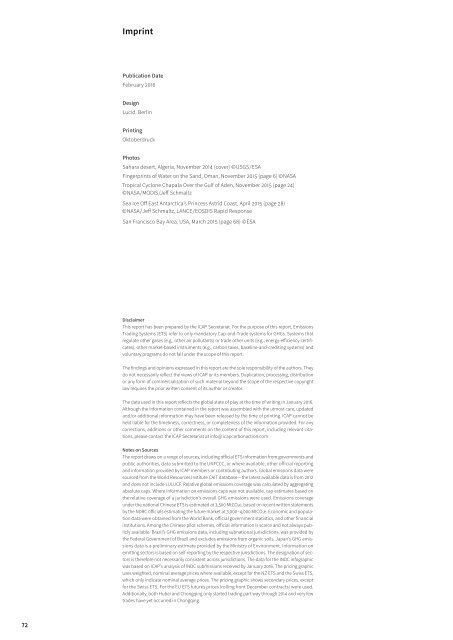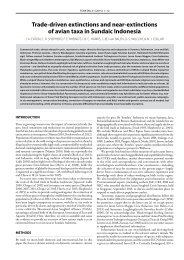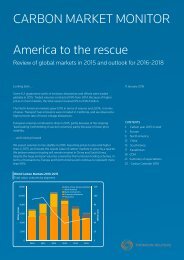Emissions Trading Worldwide
1TbjEHd
1TbjEHd
You also want an ePaper? Increase the reach of your titles
YUMPU automatically turns print PDFs into web optimized ePapers that Google loves.
Imprint<br />
Publication Date<br />
February 2016<br />
Design<br />
Lucid. Berlin<br />
Printing<br />
Oktoberdruck<br />
Photos<br />
Sahara desert, Algeria, November 2014 (cover) © USGS / ESA<br />
Fingerprints of Water on the Sand, Oman, November 2015 (page 6) © NASA<br />
Tropical Cyclone Chapala Over the Gulf of Aden, November 2015 (page 24)<br />
© NASA / MODIS /Jeff Schmaltz<br />
Sea Ice Off East Antarctica’s Princess Astrid Coast, April 2015 (page 28)<br />
© NASA / Jeff Schmaltz, LANCE / EOSDIS Rapid Response<br />
San Francisco Bay Area, USA, March 2015 (page 68) © ESA<br />
Disclaimer<br />
This report has been prepared by the ICAP Secretariat. For the purpose of this report, <strong>Emissions</strong><br />
<strong>Trading</strong> Systems (ETS) refer to only mandatory Cap-and-Trade systems for GHGs. Systems that<br />
regulate other gases (e.g., other air pollutants) or trade other units (e.g., energy-efficiency certificates),<br />
other market-based instruments (e.g., carbon taxes, baseline-and-crediting systems) and<br />
voluntary programs do not fall under the scope of this report.<br />
The findings and opinions expressed in this report are the sole responsibility of the authors. They<br />
do not necessarily reflect the views of ICAP or its members. Duplication, processing, distribution<br />
or any form of commercialization of such material beyond the scope of the respective copyright<br />
law requires the prior written consent of its author or creator.<br />
The data used in this report reflects the global state of play at the time of writing in January 2016.<br />
Although the information contained in the report was assembled with the utmost care, updated<br />
and/or additional information may have been released by the time of printing. ICAP cannot be<br />
held liable for the timeliness, correctness, or completeness of the information provided. For any<br />
corrections, additions or other comments on the content of this report, including relevant citations,<br />
please contact the ICAP Secretariat at info @ icapcarbonaction.com.<br />
Notes on Sources<br />
The report draws on a range of sources, including official ETS information from governments and<br />
public authorities, data submitted to the UNFCCC, or where available, other official reporting<br />
and information provided by ICAP members or contributing authors. Global emissions data were<br />
sourced from the World Resources Institute CAIT database — the latest available data is from 2012<br />
and does not include LULUCF. Relative global emissions coverage was calculated by aggregating<br />
absolute caps. Where information on emissions caps was not available, cap estimates based on<br />
the relative coverage of a jurisdiction’s overall GHG emissions were used. <strong>Emissions</strong> coverage<br />
under the national Chinese ETS is estimated at 3,500 MtCO2e, based on recent written statements<br />
by the NDRC officials estimating the future market at 3,000–4,000 MtCO2e. Economic and population<br />
data were obtained from the World Bank, official government statistics, and other financial<br />
institutions. Among the Chinese pilot schemes, official information is scarce and not always publicly<br />
available. Brazil’s GHG emissions data, including subnational jurisdictions, was provided by<br />
the Federal Government of Brazil and excludes emissions from organic soils. Japan’s GHG emissions<br />
data is a preliminary estimate provided by the Ministry of Environment. Information on<br />
emitting sectors is based on self-reporting by the respective jurisdictions. The designation of sectors<br />
is therefore not necessarily consistent across jurisdictions. The data for the INDC infographic<br />
was based on ICAP’s analysis of INDC submissions received by January 2016. The pricing graphic<br />
uses weighted, nominal average prices where available, except for the NZ ETS and the Swiss ETS,<br />
which only indicate nominal average prices. The pricing graphic shows secondary prices, except<br />
for the Swiss ETS. For the EU ETS futures prices (rolling front December contracts) were used.<br />
Additionally, both Hubei and Chongqing only started trading part way through 2014 and very few<br />
trades have yet occurred in Chongqing.<br />
72




